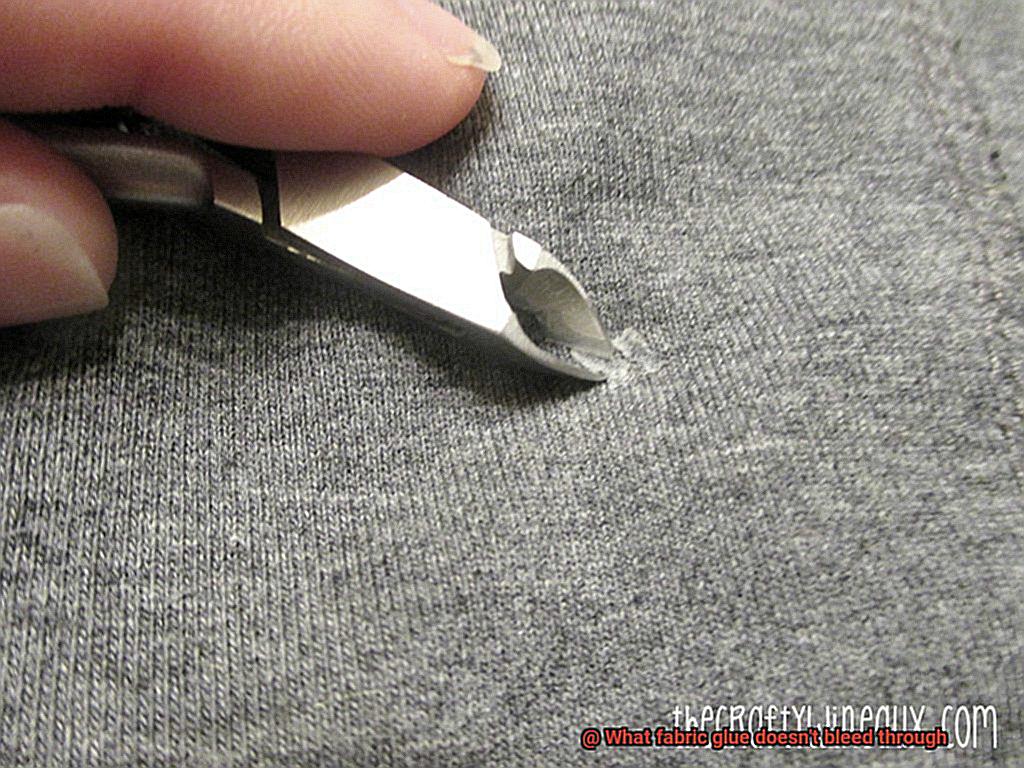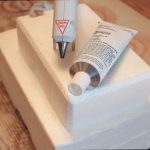Welcome to our fabric enthusiast’s haven, where we uncover the secret to flawless fabric glue that won’t bleed through. Whether you’re a seasoned crafter or just starting out on your DIY journey, we’ve all experienced the frustration of glue marks ruining our beautiful fabrics. But fear not, because we’re here to solve this age-old problem with expertise and style.
In this blog post, we’ll explore the enchanting world of fabric glue, discovering the perfect adhesive solutions that guarantee impeccable results without any pesky bleed-through. Whether you’re a casual creator looking to add a personal touch or a professional in the fashion and design industry, we’re here to rescue your masterpieces from glue-induced disasters.
Get ready for an exciting adventure as we dive into captivating details, separating the ordinary from the extraordinary when it comes to fabric glue. Are you ready to bid farewell to your fabric glue woes? Let’s jump right in and find out which glue is your new best friend.
What is Fabric Glue?
Contents
- 1 What is Fabric Glue?
- 2 What Causes Bleeding Through Fabric?
- 3 Factors to Consider When Choosing a Fabric Glue
- 4 Types of Fabric Glues That Don’t Bleed Through
- 5 Tips for Applying Fabric Glue Without Bleeding Through
- 6 How to Test the Glue Before Use
- 7 Customer Reviews: What Other People Say About the Glues
- 8 Conclusion
Fabric glue is a revolutionary adhesive that has transformed the world of crafting and sewing. Say goodbye to tedious needlework and hello to quick and easy fabric projects. In this article, we will explore the wonders of fabric glue, including its purpose, applications, and tips for choosing the perfect one for your needs.
Fabric glue is a specially formulated adhesive designed to bond fabric to fabric. It eliminates the need for sewing skills and offers a strong hold that can withstand washing and everyday wear and tear. The convenience of fabric glue is unmatched, making it a must-have tool for DIY enthusiasts of all levels.
Types of Fabric Glue:
- Liquid Fabric Glue: Perfect for precise application, liquid fabric glue comes in a bottle with a nozzle. It is ideal for hemming, appliques, and small fabric repairs.
- Gel Fabric Glue: With its thicker consistency, gel fabric glue is excellent for bonding heavier fabrics or creating stunning 3D embellishments.
- Stick Fabric Glue: Resembling a glue stick, this type of fabric glue is perfect for quick fixes and temporary bonds.
Key Characteristics of Fabric Glue:
- Washability: Fabric glue is designed to withstand repeated washing and drying without losing its adhesive properties.
- Flexibility: Unlike regular glue, fabric glue remains flexible after drying, allowing the fabric to move naturally without becoming stiff.
- Clear Drying: Fabric glue dries clear, ensuring that it doesn’t leave visible marks on delicate or transparent fabrics.
- No Bleed-through: Look for fabric glues labeled as “no bleed-through” or “bleed-resistant” to prevent unwanted stains or marks on your fabric.
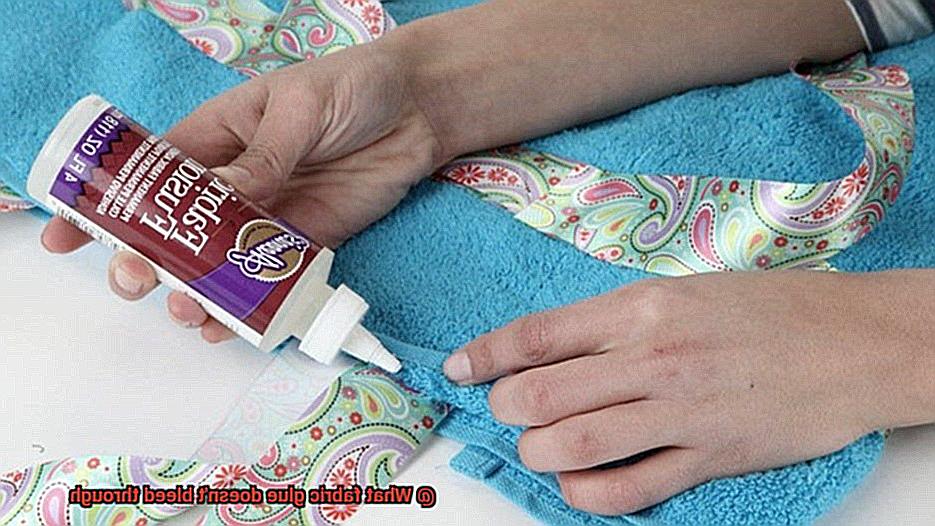
- Hemming: Say goodbye to sewing hems. Fabric glue offers a quick and easy alternative for fabrics that are difficult to sew.
- Appliques: Transform clothing or home decor items with decorative patches or embellishments using fabric glue.
- Repairs: Fix minor tears, loose seams, or missing buttons effortlessly with fabric glue.
Tips for Choosing the Right Fabric Glue:
- Consider the type of fabric you’ll be working with and choose a glue specifically formulated for that material.
- Read customer reviews and recommendations to find glues that are less likely to bleed through or leave visible marks.
- Test the glue on a small, inconspicuous area of your fabric before applying it to your entire project.
- Look for glues with a quick drying time if you’re working on time-sensitive projects.
What Causes Bleeding Through Fabric?
The unsightly stains and marks caused by adhesive seeping through the fabric can ruin a project. So, what causes this pesky problem?
The composition of the fabric plays a significant role in whether bleeding occurs. Fabrics with looser weaves or more porous fibers are more prone to the adhesive seeping through. Lightweight and sheer fabrics like chiffon or silk require extra caution when choosing fabric glue.
The type of adhesive used is another factor to consider. Specialized fabric glues are formulated to minimize bleeding through. These glues contain additives that help them adhere better to different fabrics without seeping through. It’s crucial to choose a fabric glue specifically made for your project.
Application technique is also important in preventing bleeding through fabric. Applying too much glue or spreading it unevenly increases the chances of seepage. Excessive pressure while bonding the fabric can force the adhesive into the fibers, causing bleeding.
Drying time and conditions affect the bonding process and potential bleeding issues. If the glue doesn’t have enough time to fully dry before being exposed to moisture or pressure, it may not bond properly and bleed through. Excessive heat or humidity during drying can also hinder the adhesive’s ability to set, leading to potential bleeding.
Chemical reactions between certain fabrics and adhesives can cause bleeding through as well. It’s essential to consider compatibility between the fabric and glue before making a selection.
Factors to Consider When Choosing a Fabric Glue
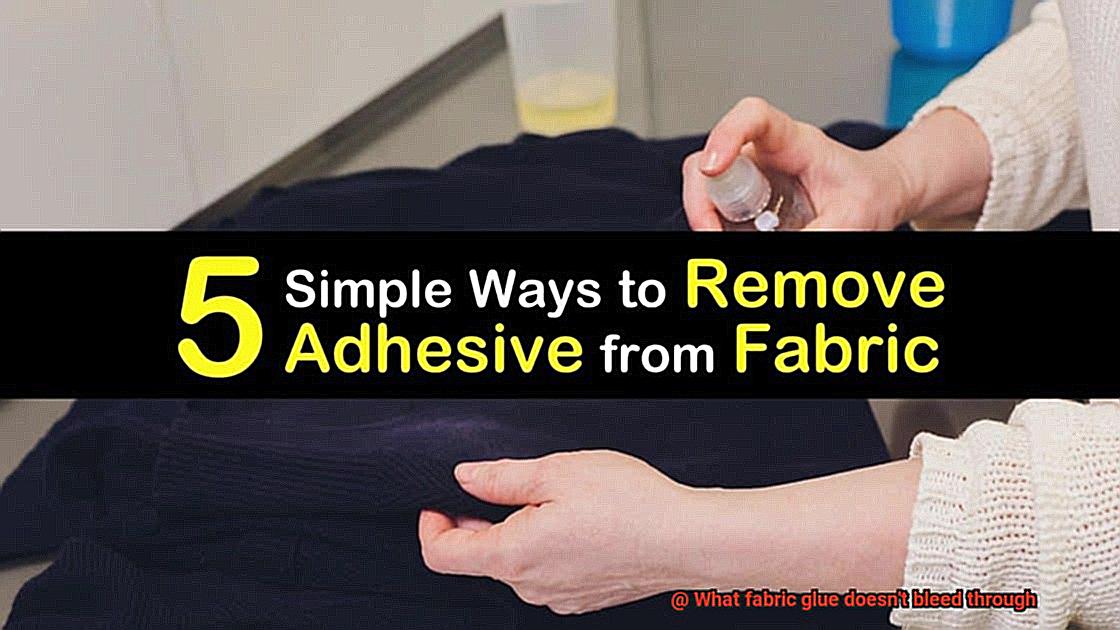
As an adhesive expert, I have compiled a list of factors to consider when choosing a fabric glue. So, get ready to stick your fabrics together flawlessly.
The first factor to consider is the type of fabric you will be working with. Different glues are designed for specific fabrics, so it is crucial to choose one that is compatible with your material. Delicate fabrics like silk or chiffon require a gentle touch, so opt for a fabric glue specifically formulated for these materials.
Next, think about the strength you need. If you’re working on heavy-duty projects like upholstery or outdoor fabrics, you’ll want a fabric glue with superior bonding strength. Look for glues with high strength ratings to ensure your creations withstand the test of time.
Drying time is another important consideration. Depending on your project’s timeline, you may need a glue that dries quickly or one that requires longer drying times. Read the label or product description carefully to determine the drying time and make sure it aligns with your needs.
If you plan on washing or laundering your fabric after gluing, washability is key. Some glues are designed to withstand multiple washes without losing their adhesive properties, while others may not hold up well when exposed to water or detergents. Be sure to choose a washable fabric glue if you want your creations to survive laundry day.
Consider the application method that suits your project and personal preference. Liquid glues are versatile and great for various fabric projects, while glue sticks offer precision for smaller applications. Adhesive tapes may come in handy for temporary fixes or quick projects.
Lastly, safety should always be a priority. Some glues contain harmful chemicals or emit strong odors, so opt for non-toxic and odorless options, especially if you’ll be working in a confined space or have sensitivities to certain chemicals.
Types of Fabric Glues That Don’t Bleed Through
Choosing the right fabric glue is crucial when it comes to crafting or sewing projects. No one wants to deal with the frustration of glue bleeding through the fabric and leaving unsightly stains. Thankfully, there are various types of fabric glues that won’t bleed through, ensuring a clean and professional finish for your creations. In this article, we will explore these different types and their unique characteristics.
Dry Adhesive:
Dry adhesive fabric glues, such as glue sticks or glue dots, are solid in form and contain no liquid or solvent. These glues quickly dry upon application, forming a strong bond without seeping through the fibers. Perfect for delicate fabrics like silk or lace, dry adhesive glues are ideal for precision work.
Gel Adhesive:
Gel adhesive fabric glues have a thick consistency, resembling gel or paste. This texture minimizes spreading or seeping through the fabric during application. Offering a strong bond, gel adhesives work well with heavier fabrics or when attaching embellishments like beads or sequins.
Non-Bleeding Formulas:
Specifically formulated to prevent bleeding, some fabric glues contain additives that keep the glue from spreading or seeping into the fabric fibers. Look for labels mentioning “non-bleeding” or “no-run” to find these glues in liquid or spray forms. They offer versatility for various projects without compromising on quality.
Solvent-Based Fabric Glue:
Solvent-based fabric glues are renowned for their strong bonding properties and resistance to bleeding through the fabric. Made with chemicals like acetone or toluene, these glues evaporate quickly, leaving behind a secure adhesive bond. They are suitable for a wide range of fabrics and can withstand washing and dry cleaning.
Water-Based Fabric Glue:
Water-based fabric glues are another popular option that won’t bleed through fabrics. These glues have a water-soluble base, making them easy to clean up and safe to use. They provide a strong bond without damaging the fabric or leaving any residue behind. Water-based fabric glues are often preferred for delicate fabrics like silk or lace.
Tips for Applying Fabric Glue Without Bleeding Through
Fabric glue is a convenient alternative to sewing, but the fear of bleeding through can deter many crafters. However, with the right techniques, you can apply fabric glue without worrying about stains or marks. In this article, we’ll explore tips and tricks to help you achieve successful fabric glue application without any bleeding through.
Use a small amount of fabric glue:
Start with a small amount of glue and add more if needed. A little goes a long way with fabric glue, so be conservative in your application.
Test the glue on a scrap piece of fabric:
Always test the glue on a scrap piece of fabric before applying it to your project. If there is no bleeding or discoloration, you can proceed confidently.
Apply the glue in thin layers:
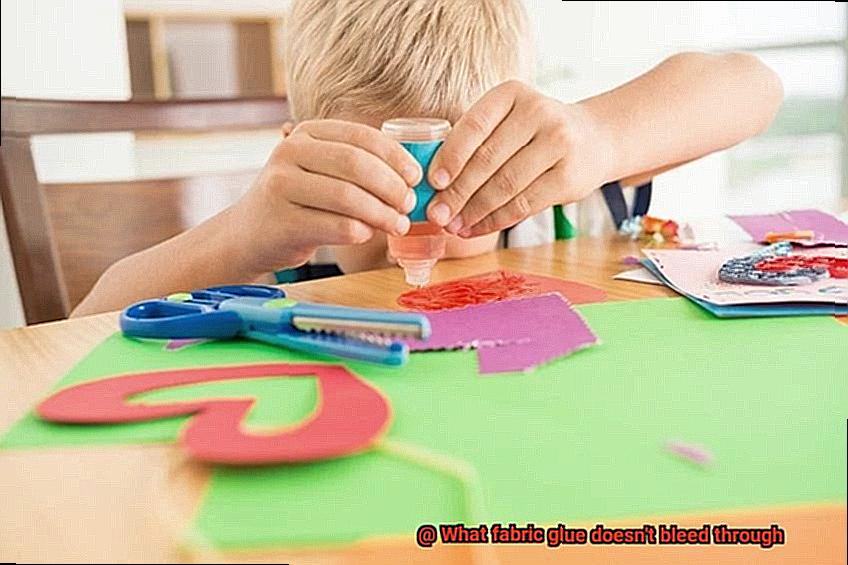
Spread the fabric glue in thin layers to ensure even drying and reduce the risk of bleeding through. Use an applicator or brush to spread the glue evenly, avoiding excessive pressure.
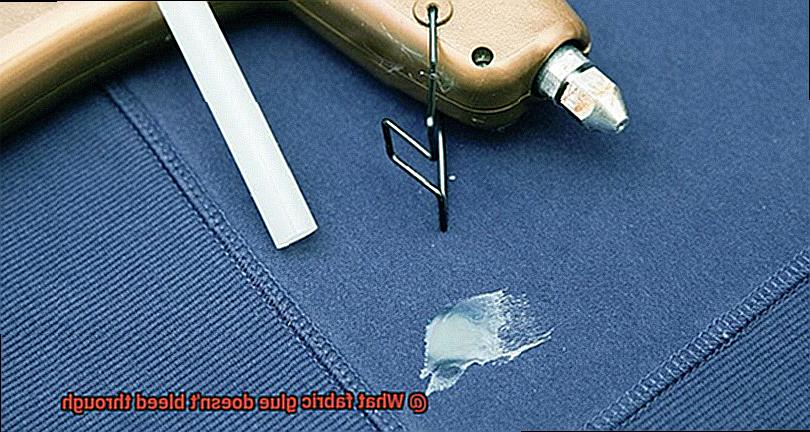
Allow the glue to dry completely before handling:
Patience is key when working with fabric glue. Allow the glue to dry fully before handling or moving on to the next step of your project. This ensures proper adhesion and minimizes the risk of bleeding or smudging.
Use a pressing cloth:
To prevent bleeding through, use a pressing cloth as a protective barrier between the iron and glued area. This reduces direct heat and pressure on the fabric, decreasing the chances of bleeding.
How to Test the Glue Before Use
When it comes to crafting or repairing fabrics, selecting the right glue is crucial. Nothing can ruin your hard work faster than glue that bleeds through the fabric, leaving unsightly marks and ruining your project. To prevent this from happening, it’s important to test the glue before use. In this guide, we will walk you through a step-by-step process of testing glue to ensure it doesn’t bleed through your fabric.
Step 1: Select a Scrap Piece of Fabric
To begin, find a small scrap piece of fabric that closely resembles the material you will be working with. Choosing a similar fabric is important because different fabrics may react differently to glue. This will give you a more accurate representation of how the glue will perform on your actual project.
Step 2: Apply a Small Amount of Glue
Apply a small amount of glue onto the fabric in an inconspicuous area. It’s best to choose a spot that won’t be easily visible, such as a corner or edge. Remember, less is often more – start with a minimal amount of glue to avoid excessive mess or waste. This will allow you to assess the glue’s performance without creating any major damage or discoloration on your fabric.
Step 3: Let It Dry Completely
Allow the glue to dry completely according to the instructions on the product packaging. This may take anywhere from a few minutes to several hours, depending on the type of glue you are using. Patience is key here. Rushing the drying process may give you inaccurate results and lead to potential bleeding issues later on.
Step 4: Inspect for Bleeding or Spreading
Once the glue is dry, carefully examine the fabric for any signs of bleeding or spreading beyond the applied area. Look for discoloration or any indication that the glue has seeped through the fibers. Pay close attention to the edges or corners where the glue is applied, as these areas are more likely to show signs of bleeding. If you notice any bleeding, it’s best to avoid using that particular glue on your fabric project.
Step 5: Perform a Wash Test (Optional)
For added assurance, you can perform a wash test on another scrap piece of fabric with dried glue. Follow the care instructions for your fabric and wash it accordingly. This will simulate exposure to water and washing to see how the glue holds up. After washing, inspect the fabric again for any signs of bleeding or damage caused by the water. This step is particularly important if your fabric project will require regular washing or if you anticipate it being exposed to water.
Customer Reviews: What Other People Say About the Glues
When it comes to choosing the right fabric glue, there’s nothing better than hearing from other people who have already put it to the test. Customer reviews provide valuable insights into whether a glue is likely to bleed through or not. Here are some tips on how to effectively use customer reviews to make an informed decision:
- Consider Multiple Reviews: Don’t rely solely on one person’s opinion. Different preferences, application techniques, and fabric types can affect the experience with a specific glue.
- Look for High Ratings: Pay attention to the overall rating of the glue. A high rating indicates that many people have had positive experiences, suggesting it is less likely to bleed through.
- Read Specific Comments: Take time to read through comments and testimonials. Look for reviews that mention whether or not the glue bleeds through fabrics.
- Visual Representation: Some customers provide pictures or examples of their projects using the glue, giving you a better idea of its performance and potential for bleeding through.
- Consider Fabric Compatibility: Not all fabric glues work well with every type of fabric. Look for reviews from individuals who used the glue on similar fabrics to what you intend to use.
- Note Recurring Themes: Pay attention to recurring themes or patterns in customer reviews. Consistent mentions that a certain fabric glue does not bleed through indicate a higher chance of meeting your needs.
- Remember Subjectivity: Customer reviews are subjective opinions based on personal experiences. Always do a small test patch on your fabric before committing to ensure the glue performs as expected.
Conclusion
In conclusion, the search for a fabric glue that won’t bleed through is crucial for any crafting or sewing project. It’s imperative to find a glue with specific characteristics like washability, flexibility, clear drying, and most importantly, no bleed-through. By opting for a fabric glue labeled as “no bleed-through” or “bleed-resistant,” you can guarantee that your adhesive won’t seep through the fabric and create unsightly stains.
Luckily, there are several types of fabric glues available that don’t bleed through, each with its own unique qualities. Dry adhesive glues such as glue sticks or glue dots dry rapidly upon application and create a robust bond without penetrating the fibers. Gel adhesive glues have a thick consistency that minimizes spreading or seeping through the fabric. Non-bleeding formulas contain special additives that prevent any bleeding from occurring. Additionally, both solvent-based and water-based fabric glues are known for their resistance to bleeding.
To apply fabric glue without any bleeding issues, it’s crucial to use only a small amount of glue. Testing it on a scrap piece of fabric beforehand is also highly recommended. Applying thin layers evenly and allowing ample time for complete drying before handling are essential steps to avoid any potential bleeding. Furthermore, using a pressing cloth as a protective barrier when utilizing heat will further safeguard against unwanted seepage.
Customer reviews can be an invaluable resource in determining whether a particular fabric glue is prone to bleeding or not. By reviewing multiple customer opinions, paying attention to high ratings, reading specific comments about bleeding concerns (or lack thereof), and considering mentioned fabric compatibility in the reviews, you can confidently make an informed decision regarding which fabric glue to select.

